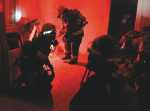'This is only a test...'

In less than 10 seconds, the smoke was already filling the room. The flames continued to burn the pile of wood and straw packed against the wall, producing the thick, gray cloud that covered the ceiling with the toxic smoke drifting closer to the floor.
The team of firefighters kneeling on the opposite side of the room took note at how fast the flames spread before they themselves were enveloped by the smoke. Relying on their instincts and training, the crew raised the fire hose and took aim. Squeezing the trigger on the nozzle, a heavy stream of water hit its mark and quickly quelled the flames.
The immediate danger had passed, but there was still a considerable amount of work ahead. The crew inside the house began to ventilate the structure while crews outside purged the remaining smoke.
Stepping out into the evening air, the rookie firefighters removed their helmets and pulled off their air masks. They smiled briefly knowing the exercise was a success.
Nearby, the next team began gearing up to fight the next battle.
Last Thursday, members of the Mountain Home Fire Department put their skills to the test during a live fire drill. Held in an abandoned home at 455 North 3rd East Street, this hands-on exercise gave the firefighters some of the most realistic training they can receive under controlled conditions, said Mark Moore, a captain with the city fire department.
While the department has a fire training simulator, it does have limitations, according to Moore. For example, the house used in last week's exercise is much larger than the simulator. Measuring 1,000 square feet, it gives the department greater flexibility where it can set these small-scale training fires.
"Live fire training is invaluable," Moore said.
During the evening, they practiced having to enter a burning structure, find the source of the flames and then extinguish the fire, he said.
Thursday's fire also gave the department's newest firefighters a first-hand look at how fire behaves in an actual structure where the conditions are not easily controlled. This included the heat inside the structure, which can reach a blistering 1,200 degrees Fahrenheit.
"A lot of this is for the department's five rookie firefighters," said veteran firefighter Alan Roberts.
This first "evolution" was all about giving the department's firefighters the training they need so they are ready to deal with an actual structural fire, added city fire chief Alan Beremsolo.
Countless hours went into preparing for Thursday's exercise, according to Moore. Crews put the finishing touches on the house just a week prior.
In addition to keeping the firefighters safe, the department focused on other risks associated with setting a house like this on fire, especially if it got out of control. The single-story house was wedged between a house just 15 feet away with a private business and motel also close by.
Throughout the evening, the training focused heavily on safety. It was already stressed in the days prior to the exercise and repeated again by the department's veteran firefighters.
There's a reason why safety is so paramount, even during training, according to Moore. In 1982, two firefighters died during a live fire exercise. It prompted a significant revision to national fire training standards, which are reviewed and revised every five years.
What came out of those revisions was a training curriculum that continues to train crews under very realistic conditions while ensuring every step is taken to keep them safe.
It's a "very controlled deal," Moore said.
The location of the house posed some unique challenges for the crews, Moore said. Among them was the location of the nearest fire hydrant, which was 150 feet from the front door. It meant the crews had to think carefully where they dropped their lines since some of the hoses were 300 feet in length. This didn't give the crews a lot of room for error when carrying these hoses inside a smoke-filled house where it's easy to get disoriented.
The age of the structure also provided additional challenges and unique learning opportunities, according to Moore.
For example, a fire that gets into a ceiling of a home like this will act differently than a similar blaze in a newer house since it wasn't built using today's stricter construction codes. It was something the department's firefighters need to keep in mind when battling fires in similar houses, Moore said.
The department hopes to squeeze another two months worth of training out of the structure, including three sessions next month and two more in early March, said city fire marshal Brian Reed. The training will conclude in late March when the department razes the structure during one final exercise.
"We do not want to burn this house down tonight," said firefighter Chuck VanMeer as he briefed the firefighters prior to Thursday's drill.
The selection of houses for these exercises requires a considerable amount of homework, Moore said in previous interview with the Mountain Home News. In addition to removing asbestos out of the walls and ceiling, which is often present in older homes, they can't have any significant structural damage.
Holes in the walls and ceiling are particularly bad since they give flames places to escape and spread through the rest of the home, according to Moore. When possible, those outlets are patched up.
When a home fits the department's needs, it can still take months to gain the necessary clearances before they schedule any training. In addition to getting written permission from the home's owner, the city needs to verify ownership of the building while ensuring the title is properly transferred.
"If we can get one house a year, that would be ideal," Moore said.
